Related Research Articles

The Boletales are an order of Agaricomycetes containing over 1300 species with a diverse array of fruiting body types. The boletes are the best known members of this group, and until recently, the Boletales were thought to only contain boletes. The Boletales are now known to contain distinct groups of agarics, puffballs, and other fruiting-body types.

The Boletaceae are a family of mushroom-forming fungi, primarily characterised by small pores on the spore-bearing hymenial surface, instead of gills as are found in most agarics. Nearly as widely distributed as the agarics, the family is renowned for hosting some prime edible species highly sought after by mushroom hunters worldwide, such as the cep or king bolete . A number of rare or threatened species are also present in the family, that have become the focus of increasing conservation concerns. As a whole, the typical members of the family are commonly known as boletes.

Leccinum is a genus of fungi in the family Boletaceae. It was the name given first to a series of fungi within the genus Boletus, then erected as a new genus last century. Their main distinguishing feature is the small, rigid projections (scabers) that give a rough texture to their stalks. The genus name was coined from the Italian Leccino, for a type of rough-stemmed bolete. The genus has a widespread distribution, especially in north temperate regions, and contains about 75 species.
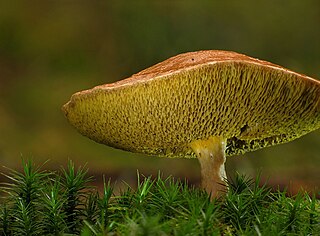
Suillus bovinus, also known as the Jersey cow mushroom or bovine bolete, is a pored mushroom of the genus Suillus in the family Suillaceae. A common fungus native to Europe and Asia, it has been introduced to North America and Australia. It was initially described as Boletus bovinus by Carl Linnaeus in 1753, and given its current binomial name by Henri François Anne de Roussel in 1806. It is an edible mushroom, though not highly regarded.

Sisyrinchium montanum, the blue-eyed-grass, American blue-eyed-grass, or strict blue-eyed grass, is a grass-like species of plant from the genus Sisyrinchium, native to northern North America from Newfoundland west to easternmost Alaska, and south to Pennsylvania in the east, and to New Mexico in the Rocky Mountains. It has also been introduced to parts of France, likely during the First World War.

Xerocomus subtomentosus, commonly known as suede bolete, brown and yellow bolete , boring brown bolete or yellow-cracked bolete, is a species of bolete fungus in the family Boletaceae. The fungus was initially described by Carl Linnaeus in 1753 and known for many years as Boletus subtomentosus. It is edible, though not as highly regarded as other bolete mushrooms.
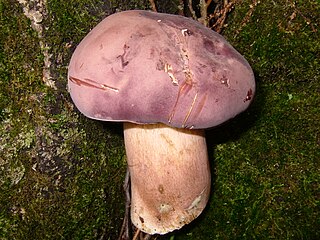
Xanthoconium is a genus of bolete fungi in the family Boletaceae. It was circumscribed by mycologist Rolf Singer in 1944, who included Boletus affinis and what was then known as Gyroporus stramineus as the type species. These two species were part of the "strange group of species described by Murrill and Snell as white-spored Gyropori, and separated by the latter under the new generic name Leucogyroporus." C.B. Wolfe described three species from the United States in 1987: X. chattoogaense, Xanthoconium montaltoense, and X. montanum. As of February 2015, the nomenclatural database Index Fungorum list seven species in Xanthoconium.

Asplenium montanum, commonly known as the mountain spleenwort, is a small fern endemic to the eastern United States. It is found primarily in the Appalachian Mountains from Vermont to Alabama, with a few isolated populations in the Ozarks and in the Ohio Valley. It grows in small crevices in sandstone cliffs with highly acid soil, where it is usually the only vascular plant occupying that ecological niche. It can be recognized by its tufts of dark blue-green, highly divided leaves. The species was first described in 1810 by the botanist Carl Ludwig Willdenow. No subspecies have been described, although a discolored and highly dissected form was reported from the Shawangunk Mountains in 1974. Asplenium montanum is a diploid member of the "Appalachian Asplenium complex," a group of spleenwort species and hybrids which have formed by reticulate evolution. Members of the complex descended from A. montanum are among the few other vascular plants that can tolerate its typical habitat.

Boletus curtisii is a species of fungus in the family Boletaceae. It produces small- to medium-sized fruit bodies (mushrooms) with a convex cap up to 9.5 cm (3.7 in) wide atop a slender stem that can reach a length of 12 cm (4.7 in). In young specimens, the cap and stem are bright golden yellow, although the color dulls to brownish when old. Both the stem and cap are slimy or sticky when young. On the underside of the cap are small circular to angular pores. The mushroom is edible, but not appealing. It is found in eastern and southern North America, where it grows in a mycorrhizal association with hardwood and conifer trees. Once classified as a species of Pulveroboletus, the yellow color of B. curtisii is a result of pigments chemically distinct from those responsible for the yellow coloring of Pulveroboletus.
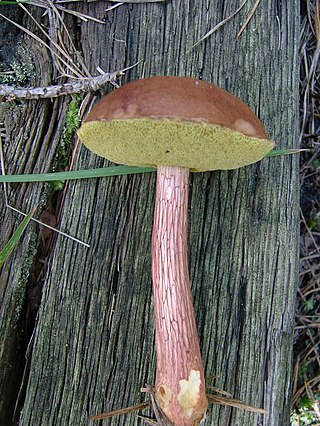
Aureoboletus projectellus is a species of bolete fungus in the family Boletaceae. Found in North America, and recently in Europe, it grows in a mycorrhizal association with pine trees.

Xerocomellus is a genus of fungi in the family Boletaceae. The genus, as it was described in 2008, contained 12 species. However X. rubellus and X. engelii were transferred to the new genus Hortiboletus and X. armeniacus was transferred to the new genus Rheubarbariboletus in 2015. Molecular analysis supports the distinction of Xerocomellus species from Boletus and Xerocomus, within which these species were formerly contained. Xerocomellus in fact is only distantly related to Xerocomus and is most closely related to Tylopilus, Boletus sensu stricto, Porphyrellus, Strobilomyces, and Xanthoconium.
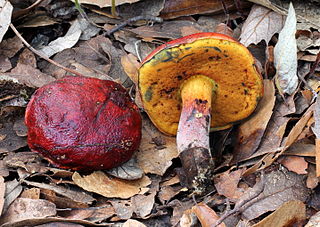
Rubroboletus dupainii, commonly known as Dupain's bolete, is a bolete fungus of the genus Rubroboletus. It is native to Europe, where it is threatened, and red listed in six countries. It also occurs in North America, although it is rare there. It was first recorded from North Carolina, and then from Iowa in 2009. It was reported from Belize in 2007, growing under Quercus peduncularis and other oaks.

Xanthoconium stramineum is a species of bolete fungus and the type species of the genus Xanthoconium. First described as a species of Gyroporus by William Alphonso Murrill in 1940, it was placed in its current genus by Rolf Singer in 1944.

Chalciporus pseudorubinellus is a bolete fungus of the family Boletaceae. It is found in North America and Central America.

Xanthoconium affine is a species of edible bolete fungus of the genus Xanthoconium. First described as a species of Boletus by Charles Horton Peck in 1873, it was placed in its current genus by Rolf Singer in 1944.
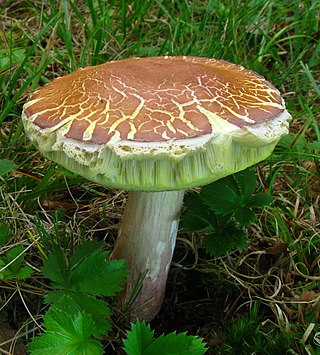
Boletus separans is a species of bolete fungus in the family Boletaceae. It was described as new to science in 1873 by American mycologist Charles Horton Peck. In 1998, Roy Halling and Ernst Both transferred the bolete to the genus Xanthoconium. Molecular phylogenetic analysis published in 2013 shows that it is more closely related to Boletussensu stricto than to Xanthoconium.
Xanthoconium chattoogaense is a species of bolete fungus in the genus Xanthoconium. Described as new to science in 1987, it is found in North Carolina, where it grows on sandy soil under Quercus alba, Quercus rubra, Acer rubrum, and Rhododendron maximum. The specific epithet refers to the Chattooga River, close to which the type collection was found.
Xanthoconium montaltoense is a species of bolete fungus in the genus Xanthoconium. Described as new to science in 1987, it is found in Pennsylvania, where it grows on soil under Betula lenta and Tsuga canadensis. The specific epithet montaltoense refers to Mont Alto campus of Pennsylvania State University, close to the type locality.

Xanthoconium purpureum is a species of bolete fungus in the genus Xanthoconium. It was described as new to science in 1962 by Wally Snell and Esther Dick in 1962. It is found in eastern North America, where it fruits under oak, sometimes in oak-pine forests.
References
- ↑ Wolfe Jr CB. (1987). "Studies in the genus Xanthoconium (Boletaceae). I. New species and a new combination". Canadian Journal of Botany. 65 (10): 2142–2146. doi:10.1139/b87-295.